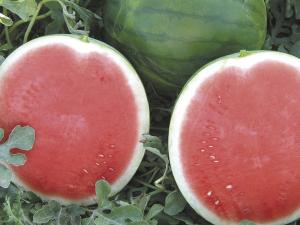There’s a trick to growing seedless watermelon
It may be an oxymoron, but it is an open secret that gardens often are controlled chaos when laid out in an irregular pattern. Seedless fruit is biologically challenging because fruits are, by definition, mature ovaries containing seeds. And how do you plant seeds of seedless fruit?
Seedless watermelons are hybrids where pollination triggers fruit development, but the ovules or embryos abort without producing true seeds. Seedless watermelons are not genetically altered, as many people think, but are simply hybrids that have been around for decades. Because most people now eat watermelon in fruit salads or cut up rather than out of hand in slices, the demand for seedless watermelons means that most watermelons sold in stores are now seedless.
Seedless watermelons grow on triploid plants, with 33 sets of chromosomes. They still need a regular seeded watermelon, called a diploid, with 22 sets of chromosomes, to provide pollen.
All watermelons (Citrullus lanatus) are tropical fruits and need to be grown in warm temperatures. You may want to germinate your seedless watermelons and their pollinators indoors with temperatures above 75 degrees Fahrenheit. Use a sterile soil mix and soak it really well, then let it dry for about 24 hours before sowing your seeds. Your indoor soil should be warm, about 90 degrees, for best germination. When the watermelon plants are six to eight inches long, you can set them out into the garden. Make sure your garden soil is at least 70 degrees Fahrenheit. Use plastic mulch to heat up the soil. Green plastic mulches are best. Plant them in full sun. Watermelons can tolerate soil pH between 5.0-6.8, but do best with soil pH 6.0-6.8.
In order to get fruit, your seedless watermelons must be grown next to the regular seeded watermelons. They will be cross-pollinated by bees and insects. Bees tend to go up and down a row rather than sideways from row to row, so alternate the seeded and seedless plants up and down each row. You will need one pollinator plant for every three seedless plants.
There are many seedless varieties of watermelons available. Orange Crisp is a striking orange-fleshed seedless watermelon with medium-thick rind. Orange Crisp fruits are round to slightly oval-shaped and weigh 14 to 18 pounds. Seeds are available from many seed houses, including Stokes and Burpee.
For old-fashioned flavor and striking looks, try Harvest Moon from Johnny’s Seeds. This gorgeous melon has the same markings as the heirloom Moon and Stars watermelon, but without the seeds.
Harvest Moon watermelons have a deep green rind spotted with tiny yellow stars and larger yellow moons. The small eight- to 13-pound fruits have sweet red flesh. As a bonus, it ripens earlier than most watermelons.
If you have patience and just a bit of skill, you can plant seedless watermelon seeds, and like a one-man band, your garden will be the impossible solution to a summer’s working holiday.























































